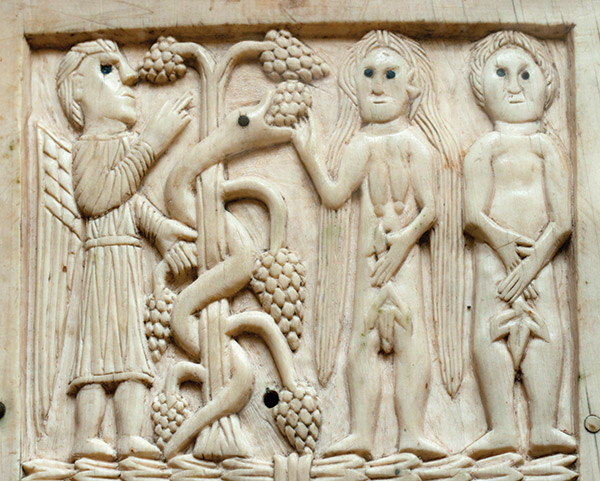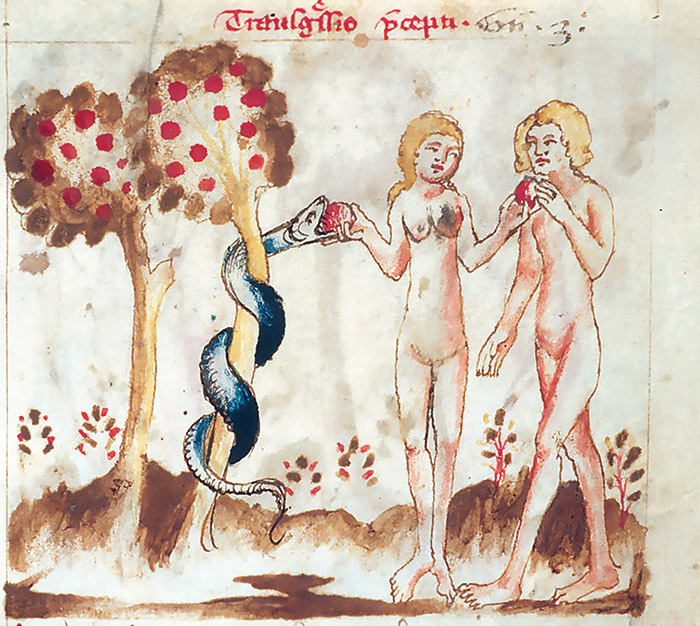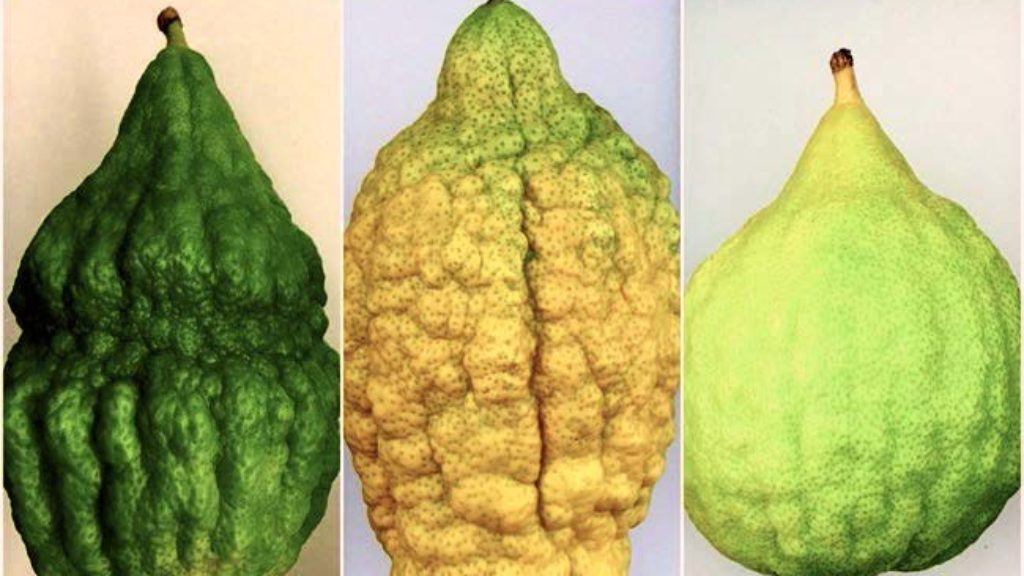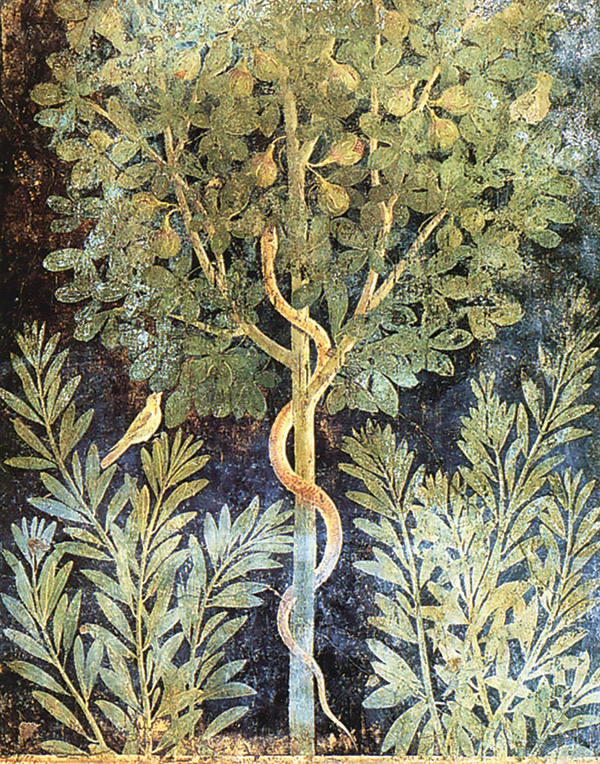Fruit of the Fall
Back in 1997, a horticulturist at Washington State University named Bruce Barritt placed pollen from a Honeycrisp on the stigma of an Enterprise apple flower. Twenty-two years of testing later the Cosmic Crisp apple was released, to great acclaim. The New York Times described it as “dramatically dark, richly flavored and explosively crisp and juicy,” almost sinfully good, one might say.
This wasn’t the first time apples burst cosmically onto the cultural scene. In twelfth-century France, apples began showing up in Christian depictions of “the Fall of Man,” everywhere from the Cathedral of Notre Dame to illuminated Bibles and psalm books. These red and gold apples supplanted the previous identification of grapes and figs as the forbidden fruit with which the serpent tempted Eve and Eve tempted Adam. Grapes and figs are low-hanging fruit, biblically speaking. The Land of Israel, for instance, is described as “a land of wheat and barley, of vines, figs, and pomegranates, a land of olive trees and honey” (Deut. 8:8)—but not of apples, not here or anywhere else in the Bible. Where did they come from? This is the central question of Azzan Yadin-Israel’s scrumptious scholarly morsel of a book, Temptation Transformed.
As readers of Hebrew will know, the story of Genesis never identifies the actual species of fruit that was forbidden to Adam and Eve in the Garden of Eden, referring to it with the generic peri (fruit). The early Aramaic, Greek, and Latin translations are faithfully generic as well: peirei, karpos, and fructus (and, importantly, as we’ll see later, pomum). The earliest interpretive tradition, dating back to 1 Enoch in the third century BCE, has the forbidden fruit “resembling a cluster of grapes.” 3 Baruch (from the first century CE) and the Apocalypse of Abraham (second century CE) take up this tradition. It is, of course, a plausible association given the grape’s intoxicating powers. The Rabbis were not particularly occupied with identifying the species of fruit in the story, but when they did take up the question, they tended to agree. Rabbi Meir, for instance, said, “That tree from which Adam ate was a vine, for nothing but wine (yayin) brings wailing (yelalah) to man (adam)” (Sanhedrin 70a).

Saint Augustine, who was himself famously tempted by a pear as a boy, nevertheless followed the other dominant ancient interpretation, which identified the forbidden fruit as a fig. This tradition is, if anything, even more textually plausible than that of the grape. Immediately after Adam and Eve ate of the fruit they realized that they were naked “and they sewed fig leaves together and made loincloths for themselves” (Gen. 3:7). This would make sense if they were standing under a fig tree. Christian artists doubled down on the fig tradition, featuring both the fruit and fig leaves prominently in the catacomb frescoes and sarcophagi depicting the sin that introduced mortality. As Yadin-Israel writes, “Fortunately, fig leaves have a distinct morphology—they are wide and consist of three to five distinct lobes—making it easier to identify the Tree of Knowledge.”
In addition to being a philological detective story, Temptation Transformed is a kind of mini- ature coffee-table book, employing forty-two images of Fall of Man art to chart the transformation from grape and fig (and a few other fruits) to apple. (Yadin-Israel has compiled hundreds more—which can be sorted by fruit, region of origin, or medium—on the book’s companion website, treeofknowledgeart.com.) And so we find ourselves accompanying the author on his linguistic-artistic expedition to discover how and why the apple came to represent the forbidden fruit of the Tree of Knowledge of Good and Bad.
Yadin-Israel is not the first to discuss this erroneous identification of the forbidden fruit with the apple. In 1646, Sir Thomas Browne published a book called Pseudodoxia Epidemica: or, Enquiries into Very Many Received Tenets and Commonly Presumed Truths, also known by the simpler title Vulgar Errors, which is what it cataloged. Book 7 concerned biblical misconceptions, first among them being that the fruit of the Tree of Knowledge was an apple. Browne suggested that some authorities had identified that as the forbidden fruit because in Latin the word “malum”means both “bad” and “apple.” As Yadin-Israel puts it:
The logic seems compelling: the forbidden fruit caused the Fall of Man, introducing death into the world—a terrible malum (“evil”) if ever there was one. What fruit, then, would medieval scholars who read and interpreted the Bible in Latin consider better suited to the role than the malum (“apple”)?
This neat explanation was taken up by modern scholars, including the distinguished twentieth-century German Lutheran scholar Gerhard von Rad and, more recently, Ziony Zevit in a widely read book called What Really Happened in the Garden of Eden? Whatever did happen in the Garden of Eden, Yadin-Israel demonstrates that this linguistic misunderstanding never occurred, no matter how plausible it sounds. It turns out that the word “malum”so rarely appears in Latin translations of Genesis that this explanation is certainly false. In fact, the word was specifically avoided precisely because of its malevolent resonance.
Yadin-Israel considers several other possibilities as to how the fruit became an apple before learnedly, patiently, refuting them. My favorite of these takedowns is his consideration of the hypothesis that the transformation was inspired by the rejuvenation of apple cultivation in twelfth-century France. Again, it sounds plausible. Quoting Erika Janik’s Apple: A Global History, and crediting the fortunately named Natan Paradise of the University of Minnesota with the suggestion, Yadin-Israel writes, “In twelfth-century Europe, the expansion of the Cistercian order of monks . . . renewed the cultivation of apples across the continent.” Understanding this hypothesis requires understanding at least the basics of apple cultivation. It turns out that every apple is a little like the Cosmic Crisp. As Yadin-Israel deftly summarizes:
Apple trees are self-incompatible, that is, the apple blossoms of one tree require pollination from another apple tree. Left to their own devices, then, new apple trees will not produce the same apples as those that provided their seeds. Farmers can combat this generational inconsistency by grafting a shoot from the parent tree onto the rootstock of the descendant, thus ensuring the offspring will be true to stock. This technique was familiar to Roman farmers, but declined in the early Middle Ages, and with it apple cultivation. Grafting was revived in the twelfth century by the monks of the Cistercian order.
But, as Yadin-Israel demonstrates, the art of apple cultivation was never really as lost as this story suggests. He quotes a Carolingian from the late eighth or early ninth century referring to “various kinds of apple trees, various kinds of pear trees, various kinds of plum trees, sorb, medlar, chestnut and peach, etc.” He further cuts down the Cistercian hypothesis by noting, among other things, that local fruit cultivation does not seem to have particularly influenced previous depictions of the forbidden fruit:
The implied causal connection between local agriculture and iconographic conventions is tenuous at best: though figs and grapes do not grow in cold climates, they figured prominently in the medieval iconography of Germany and Russia, respectively. Conversely, pears were common in France but never associated with the forbidden fruit.

There may be room to quibble here. As Yadin-Israel has already shown us earlier, figs and grapes are almost natural choices, given their ubiquity in the Bible, the association of grapes and wine with sin, and the place of fig leaves in the story. The entrenched ecclesiastical tradition identifying these fruits with the Fall would, arguably, be enough to keep them in the picture(s) even in lands to which they were not agriculturally suited. Regardless, Yadin-Israel is a master of philological and iconographic detective work, and the joy of this beautiful little book is in following his reasoning as he thinks through words (in a daunting number of languages) and images.
Much as Rashi did in the very time and place in question, Yadin-Israel eventually finds answers in the Old French. The generic word for fruit in Old French, pom, derives from the Latin pomum, which had been the Latin word commonly used to translate the similarly generic Hebrew peri. But in the twelfth century pom began specifically to designate apples. French readers of the Latin then projected this new meaning of pom onto its linguistic ancestor pomum, thereby transforming the generic fruit into their vernacular pom: a tempting apple.
Comments
You must log in to comment Log In
Suggested Reading
Who Is Man?
Two new books on sin and temptation.

When Eve Ate the Etrog: A Passage from Tsena-Urena
There was once a custom for a pregnant woman to bite off the tip of the etrog at the end of Sukkot. This excerpt includes the text of a Yiddish prayer, or tkhine, that the pregnant woman is instructed to recite based on an interpretation of Genesis 3:6.

A Moral Voice
Morality is the title of the last book Rabbi Lord Jonathan Sacks published in his lifetime. It was released in the United States in September, and he died in November at the age of 72.
Oh, the Humanity!
Would the demise or even disappearance of human beings be, on the whole, a good thing. Yuval Noah Harari seems to think so, or is at least willing to entertain the thought.

Ilan Troen
A delightful essay, and such a pleasure to discover you as an entertaining and informative author. I hope you continue to find time for this avocation and share the fruits with me.
I wonder if I might find illustrations as delightfully provocative as you have for my own book, and if my editor would permit their use.
Take good care. I look forward to being in touch.
Ilan (Hebrew for "tree" and in this song closely identified with a תפוח. Check out:
https://www.youtube.com/watch?v=i8lQSVsCp6g